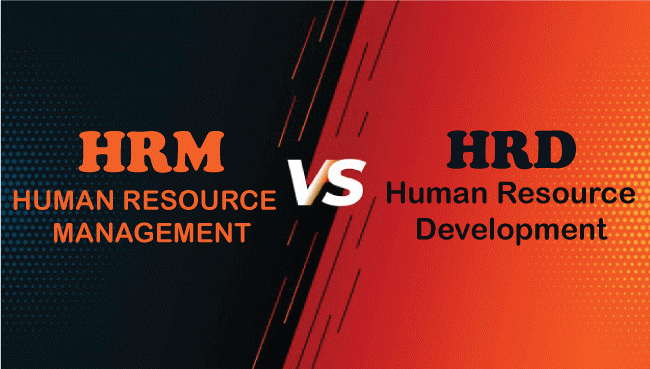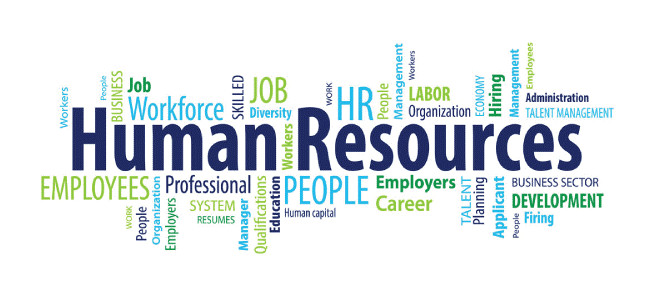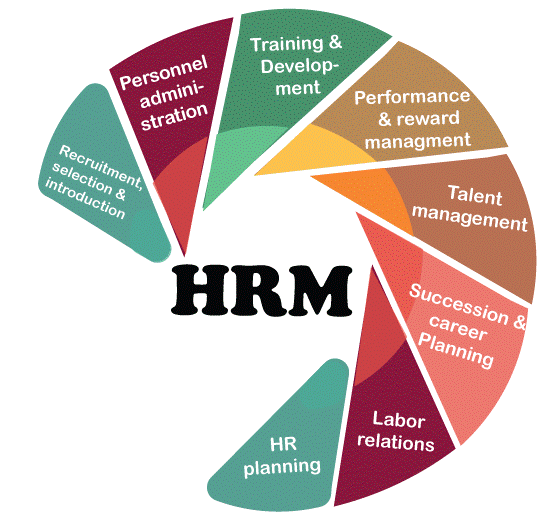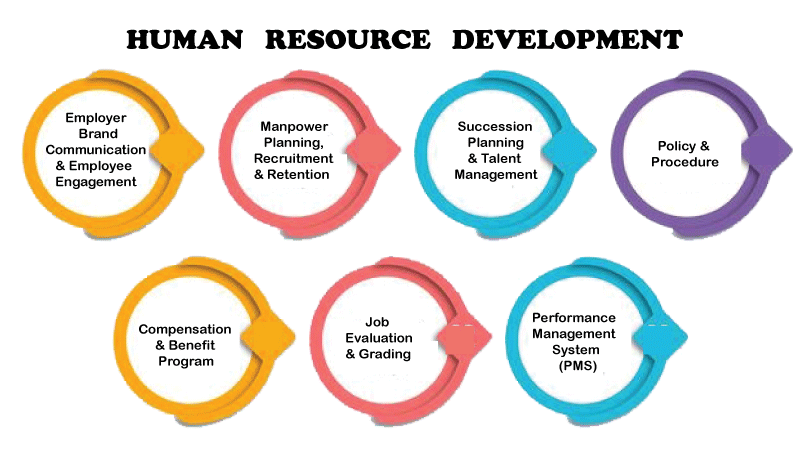Difference between HRM and HRDHRM and HRD are two vital elements of the human resources professionals that are important for the success of any organisation. HRM and HRD have to do with managing and developing personnel, but they do so with different focuses and goals. While human resource development is mostly development-driven, human resource management tends to be maintenance-oriented. IntroductionHuman resource development refers to the functions imposed to improve the actions of individuals working in a business continuously. In contrast, human resource management shows how management concepts can be used to manage the personnel who work for a company successfully. HRD is a component of HRM, which is a managerial function. 
The HRM functions are responsive and often used to achieve overall company objectives, but the HRD functions are proactive and must be used continuously to boost employee productivity. HRM aims to enhance workers' performance, whereas HRD objectives are often tied to employee competence enhancement via skill and knowledge improvement. While HRD procedures are continuous and not random, most HRM processes are regular and should be carried out when needed. HRM stands alone as a distinct entity. It is divided into many divisions, including recruiting and retention, HRD, remuneration, performance management, etc. In contrast, HRD is a subsystem of HRM and borrows many features, characteristics, and procedures from HRM. HRM only works with and focuses on individuals. HRD manages hiring, incentives, and other employee development aspects while overseeing the institution's skill-development procedures. While HRD services might be informal, such as mentorships, where workers get guidance from seniors, often managers, HRM functions are typically formal and implemented through classroom or laboratory sessions, etc. What is HRM?Human resource management, or HRM, is a branch of management concerned with organising people so that they can provide the best results for an organisation. HRM is used to implement several management ideas to help workers function successfully and efficiently in any firm. Determining how to utilise human resources most effectively raises a company's performance and production. Human resource management's primary goal is to recognise personnel as valuable resources that should be appreciated, taken advantage of, and protected. 
In general, HRM is defined as allocating the proper human resources to the appropriate positions to make the best use of a workforce within a company. Human resource management often involves recruiting, inspiring, and retaining staff inside firms. Solid market knowledge, leadership, and skilful negotiation are a few examples of fundamental expertise in HR management. Previously, it was known as personnel management. Career development, proper employee screening, training and development, talent acquisition, strategic planning, performance evaluation, coaching and mentoring, etc., are among the core tasks of HRD. Most firms across the globe have an HRD department that works to develop people from the time of their hiring until their termination. The development and implementation of employee strategies that are combined with company goals is the focus of human resource management, which also makes sure that the organisation's culture, values, and structure, as well as the calibre, dedication, and enthusiasm of its members, fully support the accomplishment of its objectives. The same functional tasks that the personnel function has historically carried out, including HR planning, job analysis, recruitment and selection, employee relations, performance oversight, staff appraisals, compensation administration, training and development, etc., are all covered by HRM. What is the Purpose of HRM?To keep and develop a company's talent, HRM aims to create, sustain, and enhance the link between the two. It is especially true now as discussions about equality and diversity in the workplace increase. Helping individuals create career pathways and resolve issues that develop inside a company, from regulation to leadership, is another goal of HRM.
What is HRD?Leonard Nadler originally proposed the idea of HRD at a seminar in the US in 1969. He described HRD as learning experiences that are planned, scheduled, and intended to have the potential to affect behavioural change. The vast area of training and growth offered by corporations to improve the knowledge, skills, education, and talents of their workers is known as human resources development (HRD). Human resource development often begins with hiring a new employee and continues throughout that person's tenure with the company. Many workers join an organisation with limited knowledge and experience; thus, they need the training to do their tasks effectively. Others could be qualified for the position already, but they may need to be made aware of the specifics that apply to that firm. HR development aims to provide staff members with the knowledge they need to work successfully within the existing objectives. The goal of HRD is to develop better workers. HR development aims to give employees the mentoring they need to enhance their knowledge, skills, and talents. The purpose of training and development is to improve workers' performance. As soon as an employee is employed, human resources development often starts and continues throughout their time with the company. What is the Purpose of HRD?HRD seeks to enhance learning and productivity at the organisational and individual levels. For both parties to gain from the connection, this might involve advancing both the general corporate objectives and the personal ambitions of the workers. Any organisation that wishes to be dynamic, growth-oriented, or successful in a rapidly changing environment needs HRD. Only through the efforts and skills of their human resources can organisations stay alive and succeed. Personnel rules may maintain employee morale and motivation, but this is insufficient to make an organisation lively and move it in new directions. Employee skills must be continually developed, honed, and applied. An "enabling" corporate culture is crucial for this goal. The company may be called to have an "enabling" culture when people take responsibility, take chances, experiment, innovate, and make things happen. Even an organisation that has outgrown its capacity for expansion must change with the times. No organisation is exempt from the need for procedures to acquire and enhance its ability for renewal and stability. Additionally, HRD detects issues in these areas and aids in creating procedures to deal with them.
Significant Differences between HRM and HRDThe following points explain the critical distinctions between HRM and HRD: 1. Basis:One of the primary distinctions between HRD and HRM is the regular use of management concepts to manage organisational workers in the HRM effectively. HRD places an enormous value on the organisation's human resources growth. It aids the organisation's staff to grow their general skills concerning their current positions and anticipated future roles. The HRD relates to a function known as "continuous development" that continually enhances employee productivity. 2. Function:While HRD is a progressive activity that meets the evolving needs of the human resources in the organisation and predicts them, HRM is a reactive role that tries to satisfy requirements as they occur in the company. 3. Process:HRM is a standard procedure and administrative duty. HRD, on the other hand, is a continuous process. Altogether, most HRM procedures are standard and must be completed as required. HRD procedures are ongoing, not occasional. 4. Goal:HRM aims to increase employee productivity, but HRD focuses on enhancing workers' knowledge, skills, and general competence. 5. ConcernedAn institutionally focused process, HRD is part of a more extensive system. The primary concern of HRD is to raise the standard of the workforce by creating an environment that promotes on-going learning. Any HRD programme would have a fixed time restriction, to be specific. Unlike HRM, To effectively manage people inside organisations, human resource management focuses on policies and processes. 6. PriorityHuman resource development is exclusively focused on people, as opposed to human resource management, which prioritises the growth of the whole corporation. 7. Dependency:HRD is a method controlled by all managers in the organisation; it is a small part of a more extensive system. Unlike HRM, this has distinct duties to fill and is thus an autonomous operation. The human resources manager is accountable to the human resources officer or manager. The HR Director is the top-level person overseeing all human resources operations and regulations. 8. Formality Levels:Most HRM functions are professional and implemented via classroom or lab instruction, etc. While, as with mentorships, where workers get guidance from superiors, often managers, HRD activities may be considered informal. What Advantages Does HRM Offer?When selecting a more promising professional path, it might be challenging to distinguish between HRM and HRD. The following are some benefits for an organisation for employing HR management: 
1. Optimisation in Staff Turnover:With the assistance of an HR specialist, the best applicants are chosen, saving the organisation a lot of money. Businesses claim it takes an average of 23 days to identify the ideal applicant for a position, while the most qualified candidates disappear from the market in only ten days. To meet their needs, appropriate wages and benefits are also provided. HR specialists primarily permit reduced employee turnover rates, which is advantageous to the company. 2. Conflict Resolution:A workplace is a place where many personalities and viewpoints coexist. HR must learn conflict resolution and managerial techniques from an excellent HR course. Standing up for both parties differs from what an HR professional wants to do since both parties should get equal assistance. 3. Employee Contentment:One of the key responsibilities of an HR practitioner is the satisfaction of their employee. Surveys, focus groups, and interviewing techniques are used to determine if potential workers are a good fit for the company. The most crucial aspect of employee contentment is that happy workers must do their duties and contribute in the company's required ways. The human capital sector uses the more general expression "employee satisfaction" to refer to how pleased or satisfied people are with their employment, their working environments, and the companies they work for. Many organisations use frequent surveys executed by HRM to assess employee happiness and monitor satisfaction patterns over time since it's one of the primary metrics that may assist in evaluating an organisation's overall health. A high degree of satisfaction indicates that workers are pleased with their employer's treatment of them. 4. Budget Manage:The HR team looks upon the annual pay of organisation members. A well-planned budget ensures that HR has the money it needs to support staff efforts and programmes essential to attracting and maintaining a qualified workforce. To concentrate on labour supply and sale analyses, which are entirely focused on job functions, they also deal with comparable and reasonable pay. 5. Educating and Developing:To reduce the necessity of hiring people for small jobs, HR professionals concentrate on evaluations to ensure that staffs are well-equipped with the necessary skills and extra certifications. Therefore, practically every enterprise and nation in the world considers HRM to be a necessary and highly valued profession. What Benefits Does HRD Offer?Human resource development is increasingly seen as the key to improving any organisation's efficiency, relationships, and profitability. Appropriate HRD offers the organisation many advantages. Integrating HRD in your workplace as an organisational leader or HR professional may help your team members and the work they generate. The advantages of HRD are listed below: 
1. Workers with Improved Skills:Employees must possess a diverse range of abilities that determine the company's potential. Most workers must have hard and soft skills, which the HRD department regularly examines. 2. Supporter for Corporate Objectives:The alignment of human resource priorities may enhance other general company objectives. For every employee to obtain practical skills and achieve their professional ambitions, the HRD team must plan essential training and development programmes. 3. Increasing Diversity in the Workforce:A competent HRD department increases the possibilities for staff members of the firm. The HRD team's orientation in terms of actions and attitudes promotes diversity in the workplace and improves organisational performance. 4. Making the Implementation of Change Simpler:Concern towards new policies or processes may be reduced by implementing change inside the company via HRD. Employees may adapt to the innovations more quickly if they understand the changes' goals and advantages. 5. Increasing the Rate of Staff Retention:People may feel more satisfied with their jobs and be more inclined to stay if they believe their employer supports their training. Human resources departments may save time and money by avoiding the need for costly and repetitive recruiting procedures when there are high retention rates. What Do Human Resources Managers Do?HR managers are responsible for various duties, including hiring and enrolling new workers, developing talent, and ensuring that the company abides by its legal employment requirements. They often support other managers throughout the organisation with issues relating to the workplace and aid in resolving conflicts amongst employees. These experts work with a company's executives to implement techniques for dealing with employees and fostering professional development. While some businesses may only have one human resources manager, others could appoint many managers to manage various department divisions. Employee relations, payroll, and recruitment managers are just a few examples of the several names for managerial positions in HR. To guarantee that both parties have the necessary tools to do their duties safely and successfully, HR departments serve as a bridge between employers and workers. Although some businesses have internal human resources departments, others could use a third party. HR managers contribute to preserving the organisational and structural integrity of the workplace in either position. Human resources (HR) may occasionally be seen as a company's administrative arm. The human resources divisions of many corporations are often seen as crucial components. They operate across many different businesses and perform various duties daily.
What Do Human Resources Developers Do?As they oversee several areas to work on within the human resources division of an organisation, including coaching, job enrichment, executive and mentorship development, quality improvement technology, and organisational learning, HR developers are significant members of the HR team in some organisations. They may be responsible for establishing mechanisms to recruit and retain talent, developing training programmes, and organising organisational development activities, such as planning workshops, among other things, on any given day. People are more dedicated to their employment when they can access the right HRD programmes. Using an accurate evaluation system, people are evaluated according to their performance. Your preparation for specialised training, instructional design, programme development, and general HR employment may be enhanced by a foundation in human resource development. For instance, training and development professionals are responsible for manuals, online learning modules, and other course content for onboarding new workers. They could also assist in evaluating training programmes or use surveys to determine staff requirements. Similarly, training and development managers are focused on an organisation's overall training objectives. They may manage experts, training courses, personnel, and budgets. How to Decide Whether to Work in HRM or HRD?For persons who want to pursue their careers in HRM or HRD, this paragraph shows some valid points regarding choosing between them. Whether you're still determining if a career in HRM or HRD is appropriate for you, there are many things to consider, beginning with your preferred work pattern and the kinds of activities and projects you want to be involved in. Individuals who genuinely love working closely with company leaders and being inspired by a wide range of various activities daily, as well as those who are looking at the organisation as a whole and examining how the HR function fits into and supports the organisation as a whole, tend to excel in HRM, according to the researches. As opposed to this, the study said that "in a more specialised job like HRD, more time will be spent working on projects in project teams, performing research, publishing, and doing programme management." "HRD is a terrific fit if that's something any individual likes and is excellent at." ConclusionHRM and HRD are different in that HRM is concerned with managing human resources for the organisation. At the same time, HRD is concerned with the organisation's workers' growth. A broader notion is that human resource development is part of human resource management. The HRM covers a variety of organisational tasks such as scheduling, staffing, constructing, tracking, sustaining, managing relationships, and analysing. In contrast, the HRD deals exclusively with the development component, including training, acquiring knowledge, career progression, talent acquisition, performance assessment, work engagement, and empowerment.
Next TopicDifference between
|
 For Videos Join Our Youtube Channel: Join Now
For Videos Join Our Youtube Channel: Join Now
Feedback
- Send your Feedback to [email protected]
Help Others, Please Share










